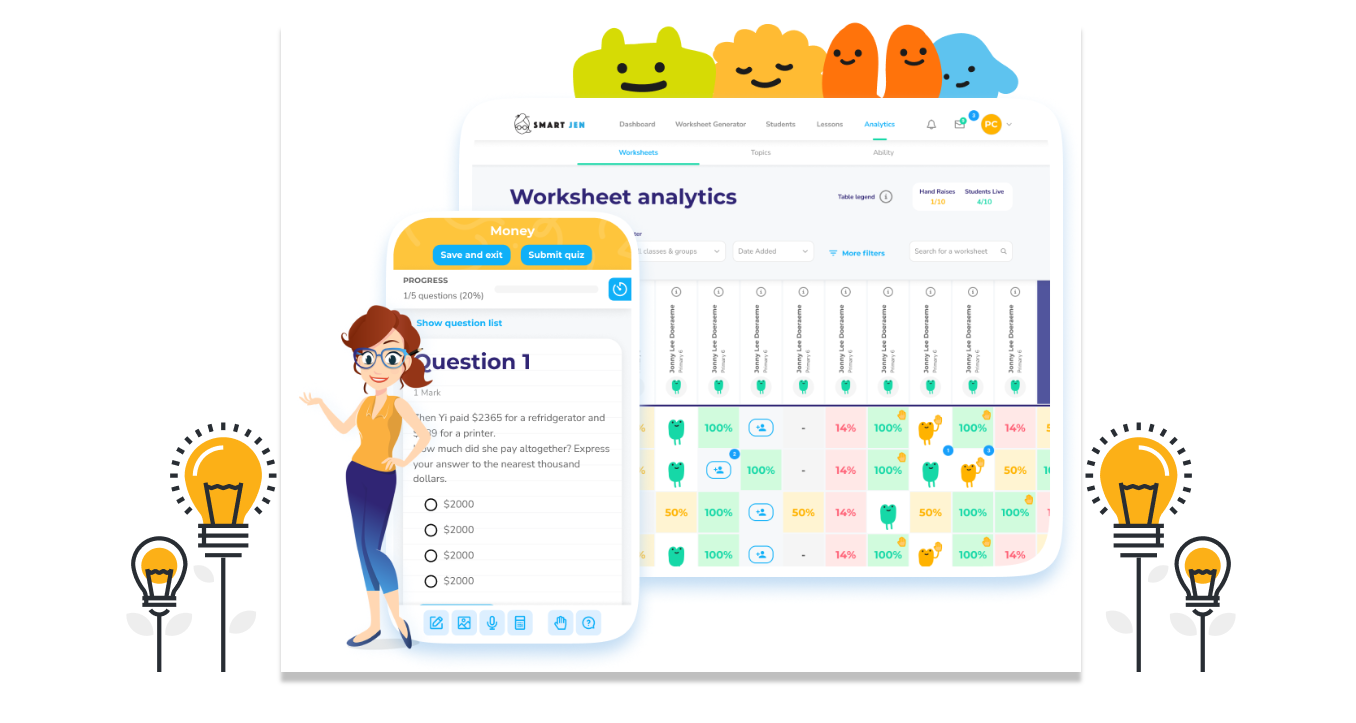As an educator, you are responsible for assessing your learners’ comprehension of the material you have covered in class. Summative assessments are important in this evaluation process because they help you to determine what your learners have learnt and indicate areas where they may require extra assistance. This article will provide you a guide to do summative assessments effectively in your classroom.
Definition of Summative Assessment
Summative assessment is a type of evaluation that takes place at the end of a learning period, such as a unit, quarter, or school year, to assess learners’ learning and determine their mastery of the lessons taught.
It is designed to summarise and synthesise the learner’s knowledge and skills acquired throughout the learning period. Summative assessment provides a comprehensive evaluation of learners’ overall understanding and ability to apply the knowledge they have learnt.
Importance of Summative Assessment in Education
Summative assessments is a crucial tool in the education system, serving several essential purposes in the classroom. Here are some key benefits of using summative assessments in education:
Evaluating Learners Mastery
Summative assessments provide a clear and objective evaluation of a learner’s understanding of the material. They allow educators to determine what a learner knows and what they still need to improve on, helping to inform future instruction and target areas where learners need support.
Assigning Grades
Summative assessments are often used to assign grades, providing a precise measure of a learner’s academic performance. These grades record the learner’s progress and can be used to track their development over time.
Preparing Learners for Standardised Tests
Summative assessments can help learners prepare for high-stakes, standardised tests they may encounter in the future, such as SAT, ACT, or state-mandated exams. These assessments provide practice in taking high-pressure tests, which can help learners perform better when the actual exams come.
Read more: A Complete Guide Of Formative Assessment in K12 Schools
Types of Summative Assessments
As an educator, it’s important to use various assessment methods to evaluate learner understanding and progress accurately. Here’s a closer look at four common types of summative assessments.
Tests and Exams
These assessments are typically written or multiple-choice assessments that measure learners’ understanding of the topics covered in a course. Final exams, typically given at the end of a course or academic term, are a common type of summative test.
Projects and Presentations
Projects and presentations are hands-on assessments that allow learners to demonstrate their understanding and application of the material creatively or practically. These assessments can take many forms, including essays, research papers, science experiments, art projects, and more.
Portfolios
Portfolios are collections of learner’s work that are used to demonstrate their progress and understanding over a period of time. These collections can include writing samples, art projects, tests and quizzes, and other assessments. Portfolios are a great way to provide learners with a visual representation of their growth and understanding.
Standardised Assessments
Standardised assessments are tests developed by educational organisations and administered to learners across the country. These assessments are designed to measure learner understanding and skills in various subject areas and can include tests such as the SAT, ACT, and state-mandated exams.
Read More: 5 Free Online Teaching Platforms for Educators
Advantages of Summative Assessment
Summative assessment is a valuable tool for educators, providing a clear and objective measure of learner learning and understanding. Here are three key advantages of using summative assessment in the classroom.
Provides a Clear and Objective Measure of Learner Learning
Summative assessments provide a straightforward way to assess learner mastery of the material. Tests, exams, and other forms of summative assessment are often scored based on established criteria, providing a clear and objective measure of learner learning.
This helps educators to accurately assess learner understanding and make informed decisions about the next steps in their instruction.
Can Be Used to Compare Learner Performance to a Standard or Benchmark
Summative assessments can be used to compare learner performance to a standard or benchmark, such as state standards or a grade-level curriculum. This allows educators to gauge learners’ progress and identify learning gaps.
It can also help educators to identify learners who are excelling in certain areas, allowing them to provide additional challenges and opportunities for growth.
Can Inform Decisions About Learner Progress and Promotion
Summative assessments are essential in making decisions about learners’ progress and promotion. For example, final exams and standardised tests can comprehensively evaluate learner mastery. This information can also decide learner placement in advanced or remedial courses.
Disadvantages of Summative Assessment
While summative assessment has many advantages, there are also some disadvantages to using this type of assessment in the classroom. Here are three key disadvantages of summative assessment.
Can Be Stressful for Learners
Summative assessments, especially high-stakes tests and exams, can be a source of stress for learners. The pressure to perform well on these assessments can lead to anxiety, frustration, and other negative emotions that can impact learner well-being and learning.
May Not Accurately Reflect a Learner’s Knowledge or Skills
Summative assessments are often limited in scope, measuring only a narrow range of skills and knowledge. This can result in a skewed view of learners’ understanding, as other important skills and abilities may not be considered.
Additionally, learner performance on summative assessments can be influenced by factors such as test anxiety, lack of sleep, or other distractions, which may not accurately reflect their true understanding of the lessons taught.
May Not Take Into Account Individual Differences Among Learners
Summative assessments are often one-size-fits-all, failing to take into account individual differences among learners. For example, a standardised test may not accurately reflect the knowledge and skills of learners with learning disabilities or English language learners.
Additionally, summative assessments may not consider differences in learning style, prior knowledge, or other important factors that can impact learner performance.
Best Practices for Administering Summative Assessments
Administering summative assessments effectively can significantly impact learner learning and success. Here are four key best practices for administering summative assessments in the classroom
Clearly Communicate the Purpose and Expectations for the Assessment
It’s important to clearly communicate the purpose and expectations for the assessment to learners, including what they will be expected to know and be able to do.
This helps learners understand the assessment’s relevance and importance and can increase their engagement and motivation.
Use a Variety of Assessment Methods to Get a Well-Rounded View of Learner Learning
To get a well-rounded view of learner learning, it’s important to use various assessment methods. This might include a combination of tests, exams, projects, presentations, portfolios, and other forms of summative assessment.
Using various assessment methods can provide a more comprehensive picture of learner understanding and help reduce the limitations of any one form of assessment.
Provide Appropriate Accommodations for Learners With Disabilities or Special Needs
It’s important to provide appropriate accommodations for learners with disabilities or special needs, such as extra time on tests or modified assessments.
These accommodations can help to ensure that all learners have an equal opportunity to demonstrate their understanding and support their success.
Use the Results of Summative Assessments to Inform Instruction and Support Learner Learning
The results of summative assessments can be a valuable tool for educators, providing important information about learner learning and understanding. Using this information to inform instruction and support learner learning is important.
This might involve adjusting teaching strategies, providing additional support and resources, or identifying areas where additional practice may be needed.
Using Online Asessment Tool to Conduct Summative Assessment

Using online assessment tools for administering summative assessments is becoming increasingly favourable due to their convenience and accessibility, allowing learners to take assessments from anywhere with an internet connection.
Online assessment tools also provide detailed reports and more comprehensive data on learner performance, helping educators to identify areas for improvement and track progress over time. One online assessment tool that has these exclusive features is HeyHi Assessment.
HeyHi also allows educators to create summative assessments using SmartJen’s vast question bank easily. It offers a holistic and integrated solution for educators to easily adopt online assessment and personalised learning. Try HeyHi now!
Conclusion
In conclusion, summative assessments play a crucial role in the education process by providing valuable information on learner learning and mastery. But it’s important to use them in conjunction with other forms of assessment, such as formative assessment, to get a complete picture of learners’ understanding.
To ensure that summative assessments are fair and effective, educators should follow best practices such as clearly communicating the purpose and expectations, using multiple assessment methods, providing accommodations, and using the results to inform instruction and support learner learning.
By doing so, they can help ensure that these assessments provide an accurate picture of learner progress and help support continued growth and success.
